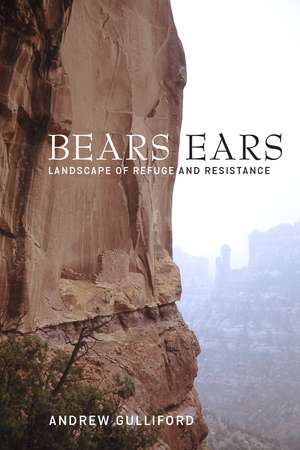Bears Ears: Landscape of Refuge and Resistance
Autor Andrew Gulliforden Limba Engleză Paperback – 30 oct 2022
Gulliford’s engaging narrative explains prehistoric Pueblo villages and cliff dwellings, Navajo and Ute history, stories of Mormon families who arrived by wagon train in 1880, impacts of the Atomic Age, uranium mining, and the pothunting and looting of Native graves that inspired the passage of the Antiquities Act over a century ago. The book describes how the national monument came about and its deep significance to five native tribes.
Bears Ears National Monument is a bellwether for public land issues in the American West. Its recognition will be relevant for years to come.
Preț: 182.30 lei
Nou
Puncte Express: 273
Preț estimativ în valută:
34.88€ • 36.50$ • 28.98£
34.88€ • 36.50$ • 28.98£
Carte disponibilă
Livrare economică 13-27 martie
Preluare comenzi: 021 569.72.76
Specificații
ISBN-13: 9781647690779
ISBN-10: 1647690773
Pagini: 512
Ilustrații: 75 illustrations, 15 maps
Dimensiuni: 152 x 229 x 38 mm
Greutate: 0.89 kg
Editura: University of Utah Press
Colecția University of Utah Press
ISBN-10: 1647690773
Pagini: 512
Ilustrații: 75 illustrations, 15 maps
Dimensiuni: 152 x 229 x 38 mm
Greutate: 0.89 kg
Editura: University of Utah Press
Colecția University of Utah Press
Recenzii
“This is a significant contribution to a current controversy. It presents multiple sides of questions fairly. In the ongoing arguments over Bears Ears, Gulliford’s book will be a resource and a reference. It presents an excellent history of Bears Ears and surrounding southeastern Utah.”
—Steve Lekson, author of A Study of Southwestern Archaeology
“Andrew Gulliford’s long experience with the lands and people of Utah’s San Juan County is apparent in this fair-minded, richly informative historical account. He shows how the Bears Ears National Monument became such a charged public issue and what can be learned from the ongoing struggle to protect it.”
—John D. Leshy, author of Our Common Ground: A New History of America’s Public Lands
—Steve Lekson, author of A Study of Southwestern Archaeology
“Andrew Gulliford’s long experience with the lands and people of Utah’s San Juan County is apparent in this fair-minded, richly informative historical account. He shows how the Bears Ears National Monument became such a charged public issue and what can be learned from the ongoing struggle to protect it.”
—John D. Leshy, author of Our Common Ground: A New History of America’s Public Lands
Notă biografică
Andrew Gulliford is professor of history at Fort Lewis College in Durango, Colorado. He is an award-winning author whose books include Boomtown Blues: Colorado Oil Shale; Sacred Objects and Sacred Places: Preserving Tribal Traditions; and The Woolly West: Colorado’s Hidden History of Sheepscapes.
Cuprins
Acknowledgments
Introduction: Bears Ears and a Deep Map of Place
1. Hunter- Gatherers and Deep Time: From Pleistocene Mammoths to Archaic Rock Art
2. From Basketmakers to Ancestral Puebloans, ad 50 to 1150
3. Into the Cliffs, 1150–1300
4. Navajos, Utes, and Canyon Exploration, 1300–1859
5. “The Fearing Time” and Mapping Ancient America, 1860–1875
6. “We Thank Thee, Oh God”: Mormons Settle Bluff and Cattle Come to the Canyons, 1876–1890
7. Cowboy Archaeology, a Lady Botanist, a Failed Indian Reservation, and the Antiquities Act, 1891–1906
8. The US Forest Service, Natural Bridges, and the Last Indian War, 1907–1923
9. Lost in Bears Ears, Murder in Johns Canyon, and a Failed New Deal National Monument, 1924–1944
10. Yellowcake, the Atomic Age, and a Golden Circle, 1945–1970
11. U-95, Nuclear Waste, Deadly Daughters, and Pothunting Raids, 1971–1986
12. Tribes Come Together for Bears Ears National Monument, 1987–2016
13. Resistance and Challenge to Bears Ears and the Antiquities Act
14. Tiny Tubers, Dark Skies, and the Future of a Sacred Native Landscape
15. Bears Ears Restored?: Coming Full Circle in Canyon Country
Notes
Bibliography
Index
Descriere
An incisive exploration of the human and environmental history of Bears Ears National Monument and its vast cultural landscape
